A recent study conducted by Chandra Kant Pawe of Pragjyotish College (Geography) and Anup Saikia of Gauhati University (Geography) has revealed that the forest cover in the Guwahati Metropolitan Area (GMA) has significantly declined over the past four decades. The researchers found that the decrease was due to various reasons such as urbanization, industrialization, agricultural expansion, and natural disasters. The research focused on 12 hills in the city and used Landsat imagery to analyze the changes in forest cover and fragmentation from 1976 to 2018.
Findings of the study
The study found that both protected and non-protected forests in GMA have experienced significant losses and fragmentation, resulting in a 50% drop in dense and moderately dense forests and an increase in non-forest areas. Dense and moderately dense forests decreased by 44% and 43%, respectively, while non-forest areas increased by 1,475 hectares between 1976 and 2018. The fragmentation of dense forests has grown as the number of small patches increased from 568 to 780.
Furthermore, both protected and non-protected forests experienced significant forest loss and fragmentation, with forest cover reduced by 21.7% and 28.5%, respectively. Today, only 11% of severely fragmented dense forests are left, and dense forest patches are restricted to only three of the eight reserved forests (RF) allocated within GMA.
The decline in forest cover has several implications, such as a decline in biodiversity, loss of habitat for wildlife, and adverse effects on climate change. Forests play a vital role in mitigating climate change by absorbing carbon dioxide from the atmosphere, and their loss can exacerbate global warming. Additionally, forests provide habitat for numerous wildlife species, and their destruction can lead to a decline in biodiversity.

Need for conservation measures
In addition, the study recommends the use of green infrastructure in urban planning, such as the incorporation of green spaces, parks, and gardens, to help maintain ecological connectivity and reduce the negative impacts of urbanization on the environment. The researchers also suggest implementing stricter regulations and enforcement mechanisms to control illegal logging, mining, and land-use changes that contribute to the depletion of forest cover. Public awareness campaigns and education programs can also play a critical role in promoting forest conservation and encouraging behavioral change towards sustainable lifestyles. The researchers urge all stakeholders, including governments, civil society, and private sector actors, to work together towards achieving sustainable development goals and protecting the natural resources in the GMA.
The researchers also suggest implementing policies to control the spread of urbanization and encourage the use of sustainable urban planning practices. Cities like Guwahati should adopt green infrastructure, such as green roofs and walls, to increase the city’s green cover. Additionally, city planners should allocate more land for parks and open spaces to provide urban dwellers with access to green spaces.
The study’s findings have significant implications for policymakers and conservationists. It highlights the urgent need for conservation measures to protect forests and their biodiversity. Forests are crucial for maintaining the ecological balance, and their loss can have far-reaching consequences. The study also underscores the need to balance economic development and environmental conservation, as unregulated development can lead to the destruction of forests and other natural resources.
In conclusion, the study conducted by Chandra Kant Pawe and Anup Saikia has revealed that the forest cover in the Guwahati Metropolitan Area (GMA) has significantly declined over the past four decades, with both protected and non-protected forests experiencing losses and fragmentation. The study underscores the importance of conservation measures to protect forests and their biodiversity and suggests implementing sustainable development practices to balance economic growth and environmental conservation. The findings of the study have significant implications for policymakers, and it is crucial that measures are taken to prevent further loss of forest cover and its consequences.












